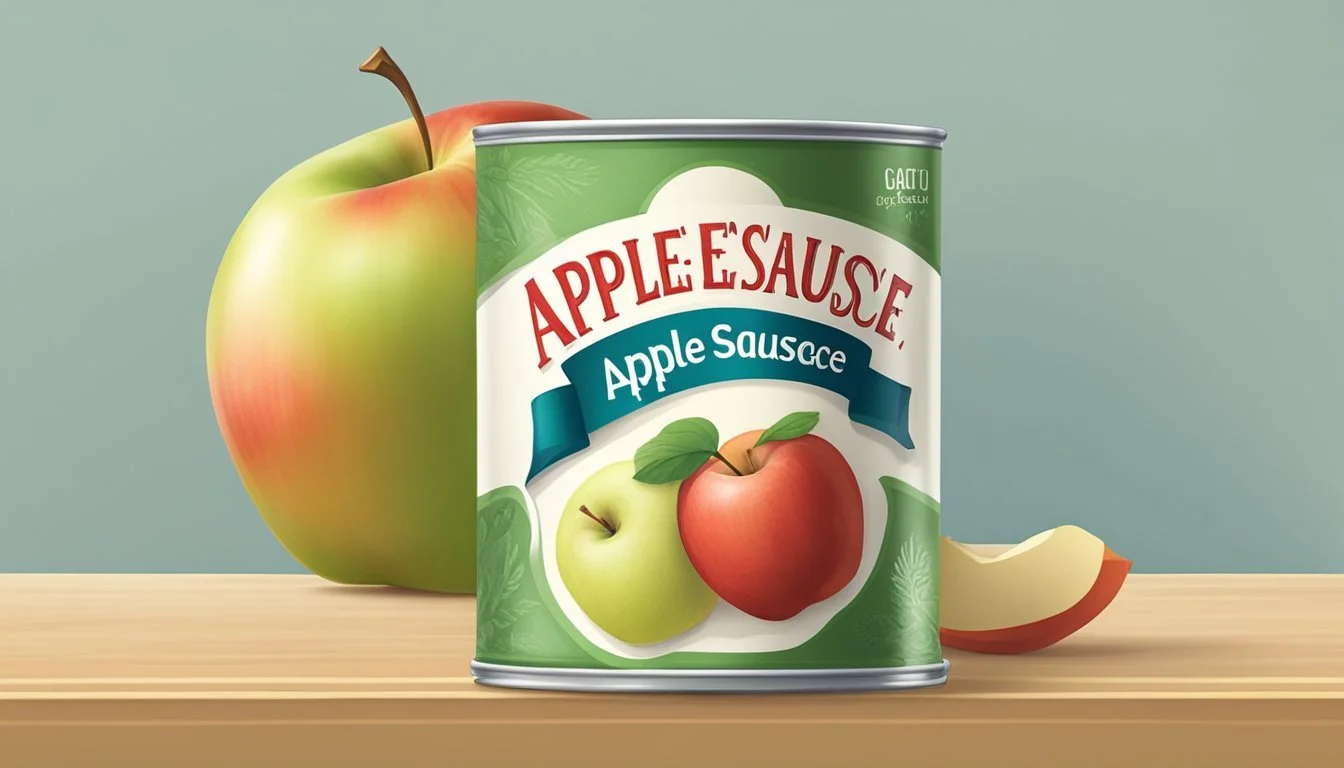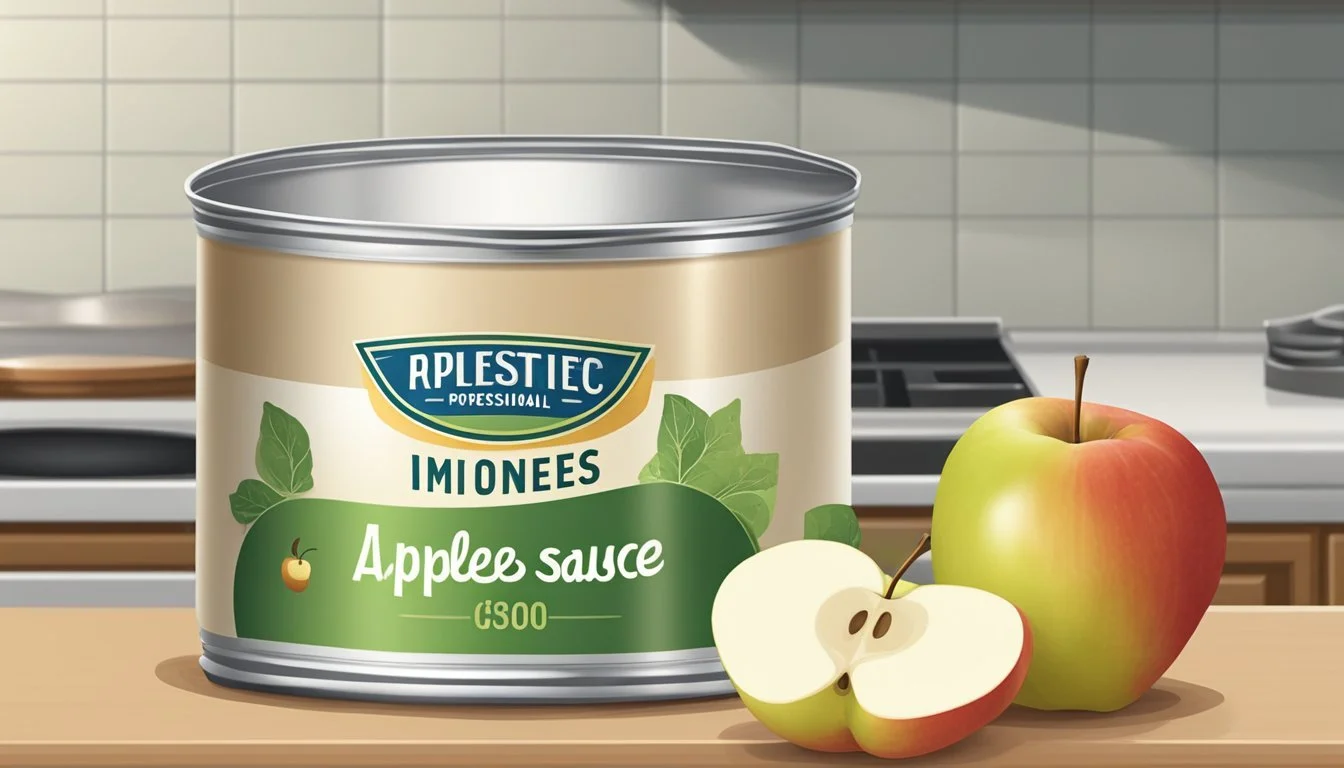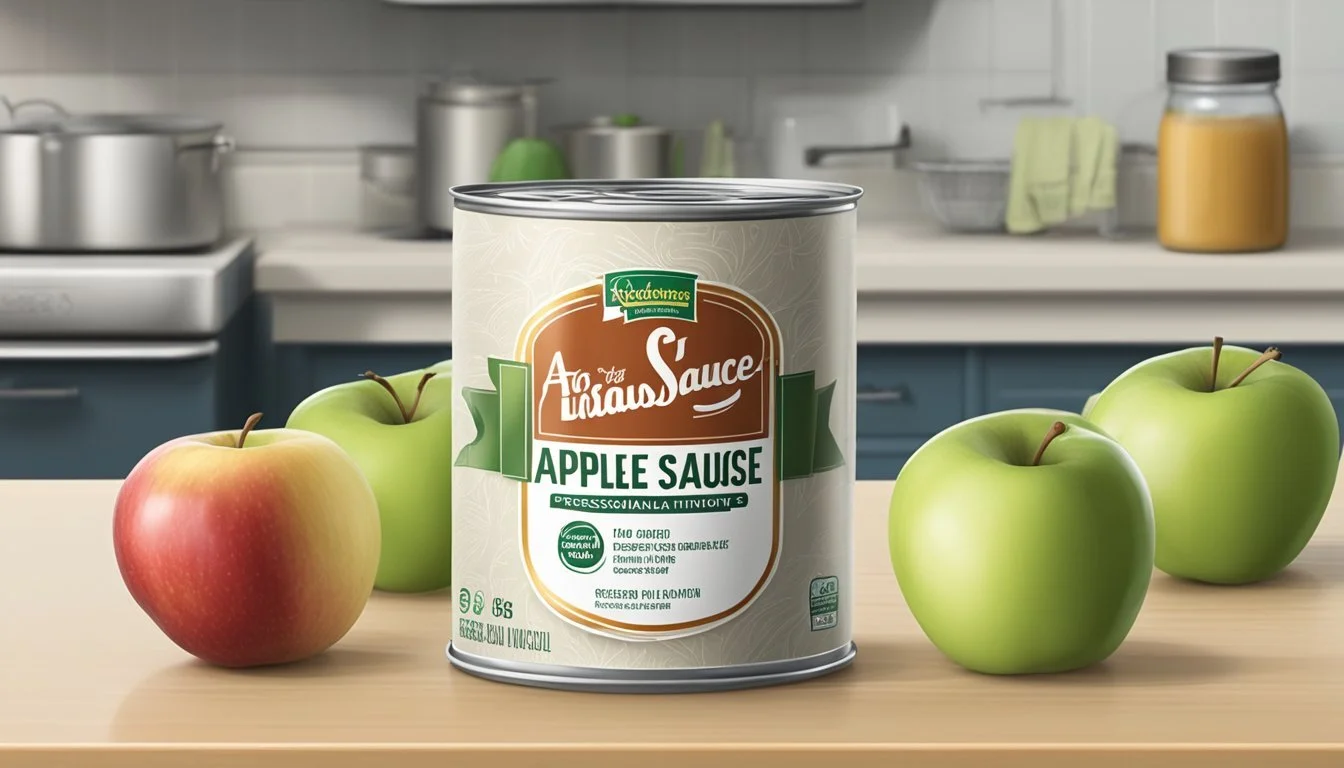How Many Ounces in a Can of Apple Sauce
Standard Sizes Explained
When determining the contents of a can of applesauce, it is essential to recognize the various can sizes available and the corresponding weight in ounces. Typically, applesauce is available in cans that adhere to standard sizes for canned goods. For example, a frequently encountered can size is the standard #10 can, which is often used in food service and bulk supply. This sizable can usually holds 109 ounces (or approximately 3.06 liters) of applesauce. Smaller, more traditional sizes found in grocery stores include cans that conveniently contain around 15 to 16 ounces, suitable for family use or individual consumption.
Canning applesauce is a method of storage that not only extends the shelf life of the product but also seals in its flavor and freshness. The process involves heating the applesauce and then transferring it into jars or cans, leaving an appropriate amount of headspace to allow for expansion. This procedure ensures that the applesauce remains safe and of high quality for consumption over time. Proper canning and storage procedures maintain the product's nutritional value and taste, making canned applesauce a reliable and readily available ingredient or snack.
Whether it's for home cooking, baking, or as a snack, consumers can choose from a variety of can sizes to meet their needs. Understanding the ounces in each size of applesauce can allows for accurate recipe measurements and ensures proper stocking of pantries and storerooms. It's a straightforward and practical matter of matching the size of the applesauce can to the requirements of the task at hand, be it for immediate use or future culinary creations.
Understanding Weights and Measures
When dealing with canned goods like apple sauce, it is vital to understand the relationship between weight and volume to ensure accurate usage and purchasing. Different can sizes are often used, and these sizes correspond to specific weights and volumes.
Ounces and Volume Conversion
Volume and weight are two distinct units of measurement often used in cooking. Volume measures the space an ingredient occupies, while weight measures the heaviness of an ingredient. For liquids and semi-liquids like apple sauce, these measurements can be converted based on standard kitchen equivalents:
1 cup is equivalent to 8 ounces by volume.
A #10 can of apple sauce typically holds about 109 ounces, which translates to approximately 13.5 cups by volume.
Apple Sauce Can Sizes
Apple sauce is commonly available in a variety of can sizes, which can be understood through their weight in ounces and corresponding volume:
Picnic can: Contains 10.5 to 12 ounces of apple sauce, which is roughly 1.25 cups in volume.
#300 can: Holds around 14 to 16 ounces, equating to 1.75 cups of apple sauce.
A #303 can typically has 15 to 17 ounces, or 2 cups by volume.
When it comes to storing apple sauce after opening, it can be transferred to mason jars. A pint-sized mason jar can hold 16 ounces or 2 cups of apple sauce, while a quart-sized jar accommodates 32 ounces, which is equivalent to 4 cups. These containers are useful for both storage and as a measurement tool for larger batches.
Nutritional Information
When assessing the nutritional profile of canned applesauce, one should consider both its health benefits and caloric density. The product typically contains a range of nutrients, serving as a healthy snack option with relatively low calories.
Health Benefits
Canned applesauce is a good source of vitamin C, which is essential for immune system function, skin health, and wound healing. It often contains no fat and can be included in a balanced diet to promote overall well-being. The presence of dietary fiber in applesauce supports digestive health, although the fiber content may be less than that of a whole apple due to processing.
Caloric Density
The caloric density of applesauce can vary depending on whether sugar is added. On average, unsweetened applesauce contains about:
50-70 calories per 1/2 cup serving
86 calories per 4 oz (approximately 113 g or a standard snack size)
For consumers attentive to calorie intake, unsweetened versions are a preferable choice to maintain a healthy weight while still enjoying the flavors of this fruit-based product.
Culinary Applications
Canned applesauce is a versatile pantry staple that integrates seamlessly into a variety of culinary uses. It acts as both a complementary ingredient enhancing other dishes and a standalone option for a quick and healthy snack.
Applesauce in Baking
In baking, chefs often substitute applesauce for oils or eggs to reduce fat content and add moisture to their creations. It works excellently in recipes for muffins, cakes, and bread. Applesauce's natural sweetness and moisture can make for lighter baked goods while also imparting a subtle apple flavor. For instance:
Muffins: For every one egg, use a quarter cup of applesauce.
Cakes: Replace half the amount of oil with applesauce to cut fat and calories.
Quick breads: Applesauce can replace up to half the fat in most recipes.
This substitution not only caters to those with dietary restrictions but also enhances the nutritional profile of classic desserts and breakfast items.
Serving Suggestions
Applesauce is not just a component in baking, but also serves as a delightful addition to various parts of a meal. Its uses include:
Breakfast: It can stand alone as a sweet, healthy start to the day or complement items like pancakes and French toast.
Side dish: Serve it as a side to breakfast items or with roasted meats (What wine goes well with roasted meats?) for dinner, adding a touch of sweetness and moisture.
Dessert: Top it on ice cream or layer it in parfaits for a quick and easy dessert.
Here's a simple way to incorporate applesauce into each part of a meal:
Mealtime Suggestion Breakfast Mix with yogurt or spread on French toast. Side Dish Accompany pork chops (What wine goes well with pork chops?) or roasted chicken. (What wine goes well with roasted chicken?) Dessert Use as a topping for vanilla ice cream.
Presentation matters as much as preparation, so consider garnishing with cinnamon or mint for added flavor and visual appeal.
Making Homemade Applesauce
Making homemade applesauce allows one to control the flavor and texture. The key points include choosing the right apples, proper preparation techniques, and preservation for long-term enjoyment.
Selecting the Best Apples
For the best homemade applesauce, one should select a mix of apple varieties. Tart apples like Granny Smith provide a lively flavor, while sweeter varieties like Fuji or Gala add natural sweetness. It is ideal to combine different types for a balanced taste.
Preparation Techniques
Prep Apples: Begin by peeling, coring, and chopping the apples. Cook the apples over medium heat in a pot, adding ingredients such as cinnamon, a hint of sugar, and a dash of lemon juice to enhance the flavor profile. For homemade applesauce, cook until the apples are soft, stirring occasionally.
Tools for Pureeing: Once cooked, one can mash the apples using a potato masher for a chunkier texture. Alternatively, a food processor or blender can be used to puree the applesauce to the desired consistency.
Preservation and Canning
To preserve the applesauce, proper canning techniques ensure safety and extend shelf life. Fill sterilized jars with the homemade applesauce, leaving appropriate headspace. Remove air bubbles and wipe jar rims clean before sealing with lids. Water-bath canning for 20 minutes will adequately process the jars. Allow them to rest at room temperature for 24 hours to ensure a proper seal.
Types of Applesauce
Applesauce varieties cater to different taste preferences and dietary requirements, offering either heightened sweetness or the pure taste of apples. These options make it versatile for consumption as a snack, side dish, or a baking ingredient.
Sweetened vs Unsweetened
Sweetened applesauce typically contains added sugars or sweeteners such as high fructose corn syrup, cane sugar, or honey. These additions enhance the natural sweetness of the apples and often appeal to those with a sweeter palate. On the other hand, unsweetened applesauce is made without extra sugars, solely relying on the natural sugars present in the apples. This type is ideal for consumers monitoring their sugar intake or who prefer the unaltered taste of apples.
Sweetened Applesauce: Often includes added sugars like cane sugar or sweeteners.
Unsweetened Applesauce: Contains only the apples' natural sugars with no additions.
Flavored Applesauce Varieties
In addition to plain applesauce, there are various flavored applesauce types that incorporate additional ingredients to create a unique taste experience. One prominent flavor is cinnamon applesauce, where cinnamon is mixed into the sauce for a warm, spiced flavor profile. Other flavors may include mix-ins like maple syrup for added richness or seasonings to enhance the freshness of the apple flavor.
Cinnamon Applesauce: Infused with cinnamon for a spiced twist.
Maple Syrup Applesauce: Sweetened with maple syrup for a distinct flavor.
Other fruit flavors or spices may be added to create unique varieties.
Another variety closely related to applesauce is apple butter, which is cooked longer into a thick, spreadable condiment, often spiced with cinnamon and other warming spices. While not a type of applesauce, it's an apple-based product that provides a deeper, more concentrated apple flavor.
Purchasing and Reviews
When selecting a can of applesauce, customers typically consider the size, brand reputation, and user reviews. Purchasing decisions can be influenced by both price and the perceived quality as reflected in user ratings.
Consumer Considerations
Consumers looking to buy applesauce in cans should note the variety of apple types used, such as Golden Delicious, Granny Smith, Gala, Honeycrisp, or Jonagold, which can affect the flavor profile. Size options vary, with a common size for larger purchases being the #10 can, which typically contains around 109 ounces. Price can vary widely depending on the brand and where it is purchased, so buyers often look for the best balance between cost and quality.
Popular Brands and User Ratings
Several brands of applesauce stand out in the market due to their consistent quality and consumer satisfaction. For instance, Musselman's and Vermont Village are frequently noted for their natural and unsweetened applesauce options. User ratings often play a crucial role in influencing potential buyers. Here is a concise overview:
Musselman's
Price: Varies by retailer
User Rating: Generally positive with mentions of a good balance of sweetness and texture.
Vermont Village
Price: Approximately $4.50 for four (4-ounce) cups or $6.50 for two (24-ounce) jars.
User Rating: Favorable reviews often highlight the organic nature and jar packaging.
Customers report satisfaction with brands offering a clear apple taste without added sugars or preservatives. A detailed inspection of customer reviews can provide insights into the quality and taste of the product, ensuring that the buyer can make an informed decision based on actual consumer experiences.
Serving and Storage Tips
When it comes to serving and storing canned applesauce, understanding the importance of container choice and optimal conditions for preservation is key. Proper storage not only maintains the quality but also extends the shelf life of applesauce.
Container Options
Canned applesauce is typically available in a variety of container sizes. These containers generally hold the following ounces:
Small can (snack size): 4 to 6 ounces
Medium can: 15 to 16 ounces
Large can: 20 to 24 ounces
For home canning, individuals often use glass jars, which come in various sizes including pints (16 ounces) and quarts (32 ounces). In home canning, the user must ensure to leave about 1/2 inch of headspace to allow for expansion and to carefully remove any air bubbles before sealing to prevent spoilage.
Shelf Life and Refrigeration
An unopened can of applesauce can typically last for 1 to 2 years when stored in a cool, dry place away from direct sunlight. After opening, applesauce should be kept in the refrigerator and is best used within 7 to 10 days.
Storage Location Condition Shelf Life Pantry Cool, dry, away from light 1-2 years Refrigerator In airtight container after opening 7-10 days Freezer In freezer-safe container, sealed Up to 12 months
For optimal quality, individuals can also freeze applesauce in a freezer-safe container. When freezing, one should leave sufficient headspace to account for expansion. Frozen applesauce can last for up to 12 months. When ready to use, it can be thawed in the refrigerator.
Creative Uses of Applesauce
Applesauce proves to be a versatile ingredient in various recipes and can serve as a healthier alternative in multiple culinary applications due to its natural sweetness and texture.
Recipes and Pairings
Muffins: Applesauce can be incorporated into muffin recipes to add moisture and a hint of sweetness. By replacing part of the oil with applesauce, bakers can produce lighter and softer muffins, while also reducing the caloric content. A ratio of 1:1 for applesauce to oil is typically used for best results.
Pork Chops: As a glaze, applesauce can be used to compliment the savory flavors of meats such as pork chops. One can spread a layer of applesauce over the chops during the final minutes of cooking to add a subtle apple flavor that enhances the meat's natural taste without overpowering it.
Healthy Alternatives
Yogurt: Applesauce serves as a beneficial addition to yogurt, especially for those seeking to reduce their sugar intake. By mixing applesauce into plain yogurt, individuals can enjoy a naturally sweetened snack without the need for additional sugars or sweeteners.
Glaze: In baking and cooking, applesauce can be utilized as a healthier glaze option for desserts and sweet dishes. It's ideal for those opting to avoid high sugar content found in traditional glazes, all while providing a smooth and glossy finish to the treat.
Engaging with Consumers
When a brand understands the importance of connecting with its audience, it adopts strategies like sharing recipes and building a community to add value beyond the product itself. These subsections discuss practical ways to foster engagement.
Sharing Recipes
Companies can stimulate consumer interest by sharing innovative recipes that feature apple sauce as a key ingredient. These recipes can be distributed through various channels, including email newsletters and posts on social media platforms such as Facebook, Instagram, or Pinterest. By doing so, brands encourage consumers to integrate apple sauce into their meals, whether they are cooking for family or entertaining friends.
Example Recipe Share on Social Media:
Post Title: "5-Minute Morning Delight"
Content: "Transform your breakfast with this quick apple sauce cinnamon toast! Just two ingredients and full of flavor. Who knew a can of apple sauce could elevate your meal?"
Companies are wise to encourage consumers to share their own apple sauce recipes. This strategy not only showcases the versatility of apple sauce but also allows consumers to take part in brand storytelling. User-generated content can be a powerful endorsement for the brand and its products.
Building Community
Establishing a community around a brand involves more than just conversation; it forms a network of support and shared enthusiasm. Brands often create online forums or social media groups where consumers can discuss not just apple sauce, but also broader topics like healthy eating, sustainable packaging, or family meal planning.
Monthly Newsletter Topics:
January: "Sustainable Start to the Year - Eco-Friendly Packaging Initiatives"
May: "Family Picnic Month - Top Picks for Easy, Quick Snacks"
Through regular engagement such as responding to comments or hosting live Q&A sessions, companies show that they value their customers' opinions and experiences. An engaged community is more likely to become loyal customers and brand advocates, spreading word of their positive experiences through their networks.
Accessibility and Availability
When discussing the accessibility and availability of canned applesauce, one must consider factors such as seasonal availability of apples and market accessibility of various package sizes. These variables can influence the availability of the product and ensure that consumers enjoy a fresh flavor, regardless of the season.
Seasonal Availability
Apples are typically harvested in the fall, which is when the freshest flavors are captured and processed into applesauce. However, due to modern storage and preservation techniques, canned applesauce is available year-round in various retail outlets. The canned product allows consumers to enjoy the taste of fresh apples outside of the traditional harvest season.
Market Accessibility
Canned applesauce is widely accessible in supermarkets, grocery stores, and online platforms. It is commonly found in the following package sizes:
Small Can: 8 ounces - suitable for individual servings or small recipes.
Picnic Can: 10 1/2 to 12 ounces - a convenient size for family meals.
#10 Can: Large can, often used in food service for bulk preparations.
Customers can typically find applesauce packaged in plastic, glass, or metal containers, providing options for those with various storage or recycling preferences. The wide range of available sizes ensures that there is a suitable option for both personal use and commercial culinary applications.
Additional Information
In this section, readers will glean valuable insights on enhancing their applesauce experience, from serving tips to creating delightful homemade gifts. The provided tips are designed to bolster the quality and presentation of canned applesauce, while the gift suggestions aim to inspire sharing homemade apple goodness with others.
Tips and Tricks
When working with canned applesauce, one can easily sweeten or flavor it to suit personal preference. For those who find the applesauce too tart, adding a touch of honey or sugar can enhance its sweetness. A sprinkle of cinnamon or nutmeg can also add an aromatic complexity, transforming a plain can of applesauce into a delicious treat.
To achieve a tender texture, use an immersion blender to smooth out any lumps. This technique is especially easy and efficient, helping create a consistently smooth applesauce without transferring it to a separate blender or food processor. Remember to blend carefully to avoid splashes, and always unplug the blender before cleaning the blade.
DIY Applesauce Gifts
Homemade gifts are often received with love, and canned applesauce is no exception. For a personalized touch, one can create DIY Applesauce Gifts by canning their own applesauce using fresh ingredients. Simply prepare the applesauce, pour it into jars, and apply the canning process to seal in the great taste.
Step Guide Sterilize Jars Boil jars and lids to ensure they're germ-free. Prepare Applesauce Cook apples to desired consistency and flavor. Fill and Seal Ladle the sauce into jars, leaving some headspace. Process in Water Bath Boil filled jars to create a vacuum seal. Decorate and Label Add fabric, ribbons, and custom labels to jars.
Employing a simple and charming presentation elevates the gift. Add a fabric topper, a ribbon, or a decorative label to the jar. Providing recipients with a recipe card for serving suggestions or additional recipes that incorporate the applesauce can also be a thoughtful addition.












